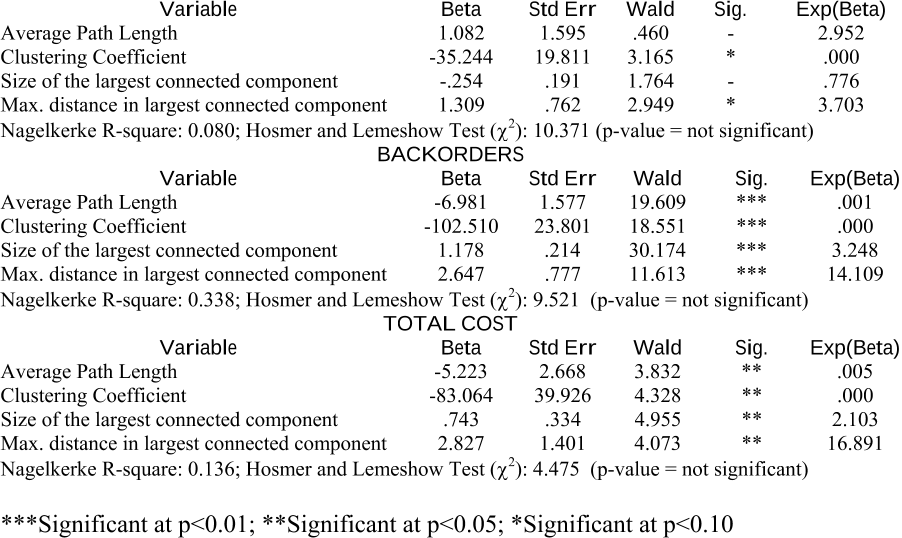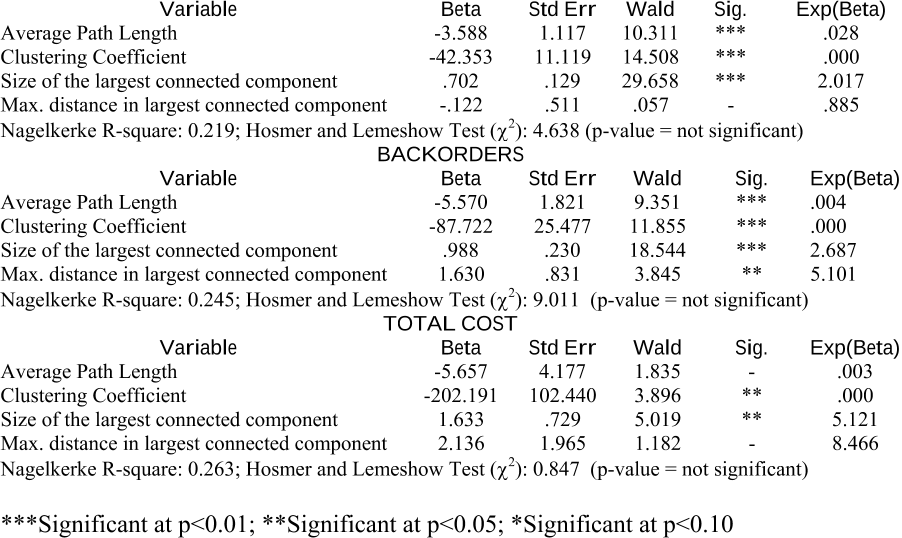




Did you find this useful? Give us your feedback










[...]
7,116 citations
863 citations
...Another important observation in literature is a linkage of SC complexity and resilience (Blackhurst et al. 2005; Nair and Vidal 2011; Bode and Wagner 2015; Dubey et al. 2019a; Tan, Cai, and Zhang 2020)....
[...]
...…and Sokolov 2013; Demirel et al. 2019) • Robustness – ability to withstand a disruption (or a series of disruptions) to maintain the planned performance (Nair and Vidal 2011; Simchi-Levi, Wang, and Wei 2018) • Resilience – ability to withstand a disruption (or a series of disruptions) and…...
[...]
545 citations
469 citations
...…this included an increased understanding of how control parameters influence dynamic behaviours and how nonlinearities impact the performance of the SC. 2.4 Complexity and reliability theory Nair and Vidal (2011) study SC robustness against disruptions using graph-theoretical topology analysis....
[...]
447 citations
...…capability, velocity capability, visibility capability, & collaboration capability • Network-level analysis with emphasis on a focal firm • Singe case study (a firm with its three supply chains) Nair and Vidal (2011) • Disruption not formally defined • Disruption as random failure and targeted…...
[...]
...Although some researchers have argued, for instance, that high-degree nodes (Craighead et al., 2007) and short average path length (Nair and Vidal, 2011) play critical roles in network disruption, our analysis shows that node failure and average walk length are not necessarily related with a…...
[...]
...• No operational measures for resilience • Unclear level of analysis • Survey Table 1 (Continued) Referencesa Definition Level of definition and analysis Methods/nature of study Main findings Conceptual definition Operational measuresb Wagner and Neshat (2010) • Disruption as “the trigger that leads to the occurrence of risk” (p. 122) • Not operational measures for disruption discussed; but instead, supply chain vulnerability drivers categorized into demand side, supply side, and supply chain structure • Unclear level of definition • Empirical • Propose a SCVI (supply chain vulnerability index) metric that can be used to assess the vulnerability of supply chains and compare vulnerabilities of supply chains across industries • A related concept, “vulnerability” is discussed • No operational measures for resilience • Level of analysis: multiple & mixed (a firm, supply chain, industry, and entire economy) • Survey • Resilience not discussed Jüttner and Maklan (2011) • Disruptions “imply a certain level of turbulence [Hamel and Valikangas, 2003] and uncertainty in the supply chain [van der Vorst and Beulens, 2002]” (p. 247) • No operational measures for disruption • Network-level definition • Qualitative • Suggest that supply chain risk and knowledge management enhance resilience by improving flexibility, visibility, velocity and collaboration capabilities at the supply chain/network level • Resilience defined by flexibility, velocity, visibility, and collaboration capabilities (adapted from Ponomarov and Holcomb, 2009) • Resilience measured as flexibility capability, velocity capability, visibility capability, & collaboration capability • Network-level analysis with emphasis on a focal firm • Singe case study (a firm with its three supply chains) Nair and Vidal (2011) • Disruption not formally defined • Disruption as random failure and targeted attack on network nodes (firms) for their inventory levels, backorders, and total costs • Network-level definition • Analytical • Certain established network characteristics (such as average path length, clustering coefficient, size of the largest connected component) are associated with the robustness of supply networks (to random failures/targeted attacks on demand and uptime of nodes) • Resilience (robustness) not formally defined • Resilience (robustness) as multiple network attributes such as average path length, clustering coefficient, size of the largest connected component (LCC), and max. distance between nodes in the LCC • Firm-level analysis • Simulation (agent-based modeling) Zhao et al. (2011) • Disruptions “affect the normal operations” (p. 1) and are either random or targeted • No operational measures for disruption • Network-level definition • Analytical • Suggest centrality as a measure for a node’s importance....
[...]
...…al., 2010; Wagner and Neshat, 2010), conceptual (e.g., Christopher and Peck, 2004; Kovács and Tatham, 2009; Tang, 2006), qualitative (e.g., Craighead et al., 2007; Jüttner et al., 2003; Sheffi and Rice, 2005), and simulation/modeling (e.g., Nair and Vidal, 2011; Wu et al., 2007; Zhao et al., 2011)....
[...]
...This also conflicts some research on supply network resilience that argues for the association between the well-established network metrics and resilience (e.g., Nair and Vidal, 2011)....
[...]
1,425 citations
1,373 citations
1,124 citations
...For instance, studies have examined the financial implications of supply chain disruptions (e.g. Hendricks and Singhal 2003, 2005) and investigated risk mitigation and contingency planning strategies in the presence of supply chain disruptions (e.g. Sodhi 2005, Tomlin 2006)....
[...]
884 citations
779 citations
...For instance, studies have examined the financial implications of supply chain disruptions (e.g. Hendricks and Singhal 2003, 2005) and investigated risk mitigation and contingency planning strategies in the presence of supply chain disruptions (e.g. Sodhi 2005, Tomlin 2006)....
[...]